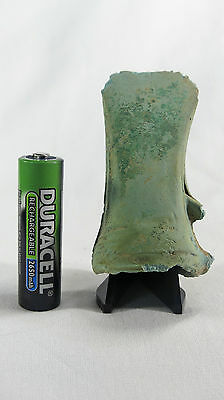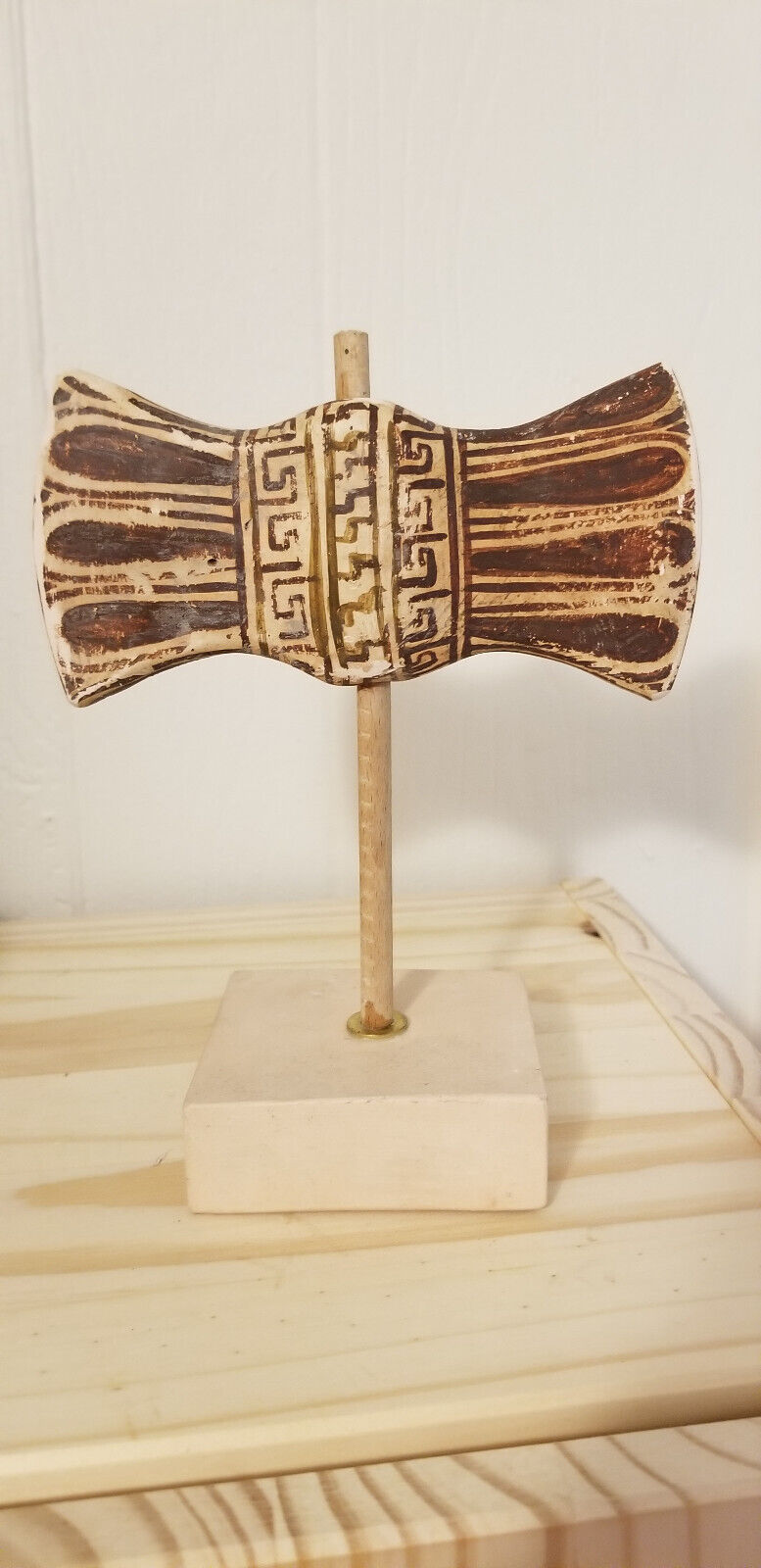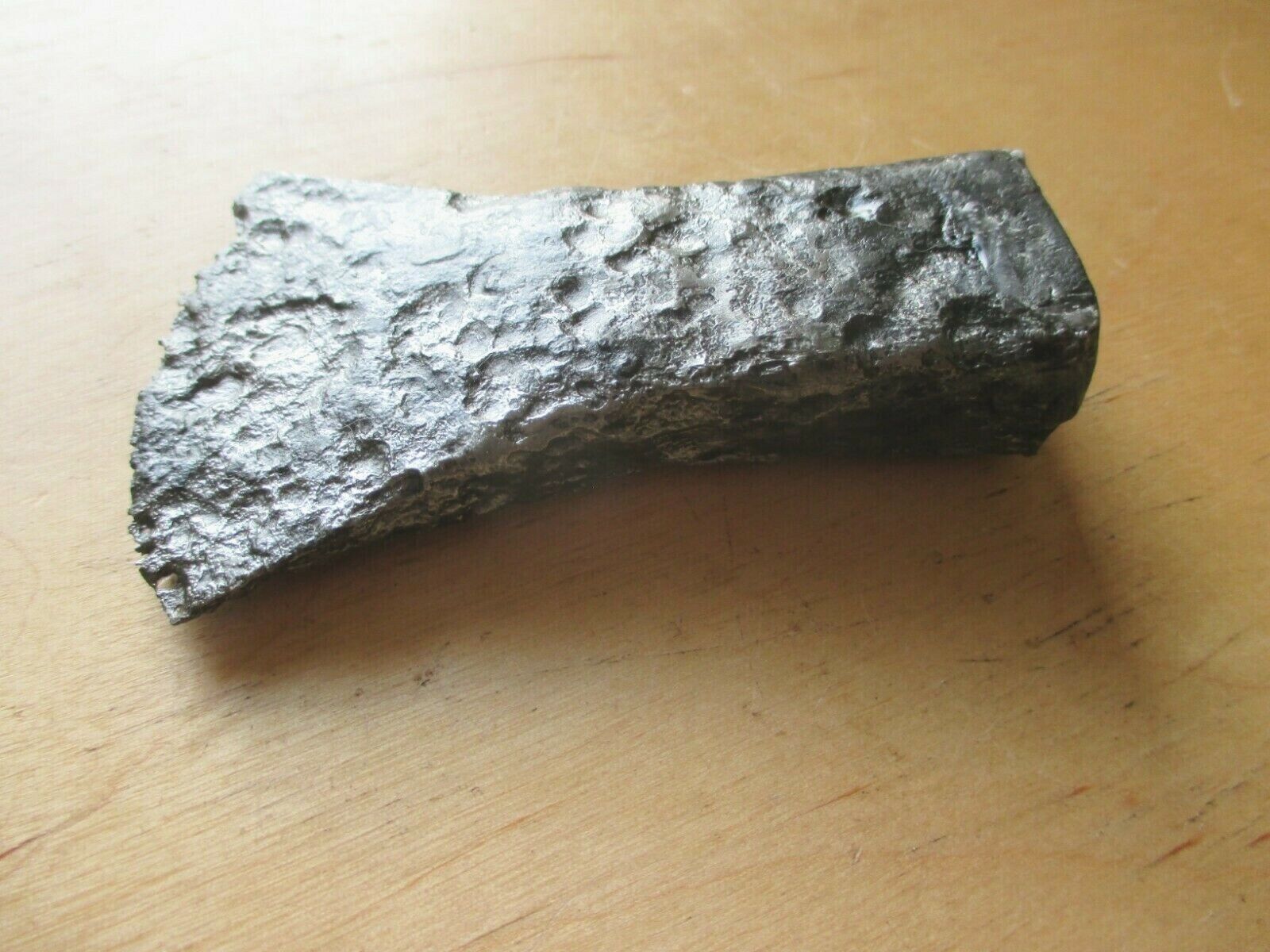-40%
Ancient Celtic Votive Axe Head Offering to the Gods! c. 1000 BC--500 BC!
$ 198
- Description
- Size Guide
Description
ANCIENT CIVILIZATIONSArtifacts, Antiques & Fine Collect
i
bles
Ancient Ritual Celtic Axe Head
Celtic Votive Offering to the Gods
c. 1000—500 BC
Item:
Ancient Celtic Votive Axe Head
Material: Pottery
Est. Date:
c. 1000 BC—500 BC
Weight:
2.8 oz. (80 gr.)
Length:
2.7" (70 mm)
Width:
1.6" (40 mm)
Provenance: Found near Ternopil, Ukraine, in the Carpathian Basin
DETAILS
This rare, early Votive Celtic axe head was molded from clay and fired approximately 2,500 years-ago.
Even small, ritual axes such as this one were thought to be immensely powerful to ward off evil spirits and to grant wishes.
The greatest number of recorded offerings were promised or given to the gods as thankfulness for favors bestowed or intelligently anticipated, while other offerings were offered due to fear.
{
Source: Acropolis Museum in Athens
}
Because of this association with power, many bronze items were buried with their owners or makers, while pottery items were tossed into rivers and marshes as votive offerings.
This small, pottery, votive axe head has a wonderful patina of green algae and white minerals (largely calcium) that strongly suggests it was thrown into a river or presented to the gods at a temple/oracle over 2,500 years-ago.
Small axes were never toys for children, and instead were only found in the tombs of kings and warriors or as votive gifts at oracles and temples.
{
See Acropolis Museum in Athens}
Greatest number of recorded offerings were promised or given as thankfulness for favors bestowed or intelligently anticipated, others were offered due to fear.
The discovery and sale of such artifacts from this era is always a cause for excitement, and to find such items of beautifully preserved votive items on the market is quite momentous.
While bronze, votive axes are more common, ones made of pottery are extremely rare as the clay pottery can rapidly deteriorate in water if not fired at a high enough temperature.
Ancient Greek Votive Axe Head
Small Axe Dedicated to the Temple Gods
In ancient Greece, the practice of dedicating objects to deities was common.
It appears to have been a natural outcome of gratitude for the benefits received by a person who asked for a god’s assistance. The dedicated objects could be large or small, depending upon the nature of the request.
For example, the nine archons at Athens took an oath upon entering the office that they would dedicate a gold statue at Delphi that was equal in size to them if they transgressed the laws.
Gold, jewels, statutes, silver, bronze offerings or even a small as a piece of terracotta pottery could be offered to the gods.
Archeologists believe that the ancient Greeks thought the gods would be more likely to grant their wish or request if the applicant for their benefits promised something of value in return—an offering. The Romans had a phrase “
voti reus
” that means “condemned to pay a vow” once a prayer had been granted by the gods.
Temple officials would inventory and catalog these votive objects and in the case of precious metals would record the weight of each item or the number of jewels in a necklace.
Possible offering to Zeus or to Ares, the God of War.
Price & Value
Each object I sell is professionally researched, translated (if I can...(smile), and compared with similar objects in the collections of the finest museums in the world.
I have been dealing in fine antiquities for over 45 years and although certainly not an expert in every field, I have been honored to appraise, buy, collect, and enjoy and recently sell some of the finest ancient art in the world.
When in doubt, I have worked with dozens of subject matter experts to determine the condition and authenticity of numerous antiquities and antiques.
This careful examination helps to insure you are buying quality items and helps to protect your investment.
There are many modern reproductions or "fakes" on the market today, so be sure and buy only from experts in the field.
Please examine the photos taken at 4x macro carefully as they are part of the description.
The AA battery and the stand are not part of the auction, just included to give you a better perspective.
And please ask any questions before you buy.
Thanks for looking and I'm always happy to combine shipping to save you even more money.
Note:
Please ask any questions you may have before you bid! Thanks for Looking!
Per e-Bay's rules, PayPal only please!
THANKS!
US Buyers only please!
FREE SHIPPING & Insurance included for all 50 United States.
ANCIENT CIVILIZATIONS
Artifacts, Antiques & Fine Collect
i
bles
Ancient Ritual Iron Battle Axe Weapon
Near Eastern Scythian Warrior Axe
c. 600 BC to 400 BC
Item: Ancient Scythian Ceremonial or Votive Iron Axe
Material: Iron
Length: 5.5” (140 mm)
Height:
1.45” (37 mm)
Weight: 5.3 oz. (150 gr.)
Civilization:
Ancient Scythian Peoples
Est. Date: 600 BC—400 BC
Condition:
Well preserved, it shows the heavy pitting and oxidation (rusting) of a genuine artifact that has been buried for about 2,500 years.
The item has been treated with electrolysis and thus has a black coloration.
It is protected by a museum approved, micro-crystalline wax by Renaissance Wax to reduce further oxidation.
DETAILS
This historic, museum-quality, Scythian Ceremonial Warrior Battle Axe dates to about
600 BC—400 BC.
It is made of iron and was made by the Scythians to be attached to a wooden handle via tethered binding.
Its small size suggests it was intended
for ceremonial or votive purposes and
not
made for or used in actual warfare.
It is likely that it was part of a large burial tomb for a noble Scythian warrior who fell in battle about 2,500-years-ago.
This artifact has been professionally cleaned and treated with an electrolysis process developed and formulated for ancient metal preservation. The patina shows beautiful traits only found in authentic ancient weapons that have been buried for thousands of years.
From a very early period, the ancient Iranian peoples have been historically documented to exist in two separate continuums - a western civilization (Persia) and an eastern civilization (Scythia).
In the sixth, fifth and fourth centuries BCE, the Persians discerned several nomadic tribes on the Central-Asian steppe; they called them
Sakâ
. We know the names of these tribes from Persian royal inscriptions and can add information from Herodotus and other Greek authors.
See details below.
SCYTHIANS
Scythian, also called
Scyth, Saka, and Sacae
, were members of a nomadic people, originally of Iranian stock, known from as early as the 9
th
century BCE who migrated westward from Central Asia to southern Russia and Ukraine in the 8
th
and 7
th
centuries BCE. The Scythians founded a rich, powerful empire centered on what is now Crimea. The empire survived for several centuries before succumbing to the Sarmatians during the period from the 7
th
century BCE to the 2
nd
century CE.
The
Scythians
were contemporaries of the Greeks and greatly feared by them. Much of what we know about them is based on accounts by Herodotus, the founding father of history, who wrote about the Scythians in the 5th century B.C. Other information about them has been gleaned from archeological excavations and accounts from other Greek historians.
Herodotus wrote extensively about the Scythians an it is not clear how much was based on first-hand observation or second-hand accounts, but the latter seems most likely. It is also not clear how extensively Herodotus traveled in the Black Sea-Dnieper River heartland of the Scythians.
On one journey around 450 B.C., he probably reached Olbia, 40 miles west of the Dnieper River.
Herodotus described the Scythians as savage warriors who committed many atrocities. Some think that Herodotus gave the Scythians an unjustified, prejudiced bad rap, but in all probability, they committed no more atrocities than the Romans, Persians, Egyptians or even the Greeks themselves.
Although they had no written language many scholars believe the Scythians spoke an Iranian language. German Scythian expert Hermann Parzinger told National Geographic:
“From ancient sources we know the names of several tribes, and they seem to be Iranian names. There were different groups, but they had the same way of life and same burial customs.”
For a period of 30 years in the 6th century B.C., Herodotus wrote, the Scythians burst out the Black Sea region and across the Caucasus and raided communities in Asia Minor and the Middle East. They migrated as far westward as Germany and captured land formerly controlled by the Medes in present-day western Iran and by the Assyrians in Mesopotamia. The pillaged cities as far away as Palestine and Babylon before they were finally driven back by the Medes.
At the height of their power in the 4th century B.C., the Scythians controlled an empire that covered much of what is now southern Russia and the Ukraine and stretched 4,000 miles from eastern Europe to Mongolia.
Scythian Warriors and Weapons
According to Herodotus, the Scythians were ruthless and nearly invincible warriors who made cloaks from their victim’s scalps and drank from their skulls and sacrificed one out of every hundred prisoner of war. Wealthy Scythians reportedly gilded the insides of the skulls of their enemies and used them as drinking cups.
Scythians are credited with creating the first truly effective cavalry and employing tactics described as an ancient version of the
blitzkrieg
. They attacked their enemies on horseback and cut down their enemies with weapons shaped like this smaller, ritual example. They were difficult to fight against because they traveled swiftly on horseback and their nomadic ways made them difficult to attack and even find their base of operations.
I
GUARANTEE
this axe head is ancient and authentic or your money back!
NOTE: This ancient axe head is still sharp and you must be 18-years-of-age or older to bid on it.
Please check with local laws if it is legal to own in your state/county/city. THANKS! :)
Note:
Please ask any questions you may have before you bid! Thanks for Looking!
Per e-Bay's rules, PayPal only please!
THANKS!
FREE SHIPPING includes INSURANCE for all 50 United States.

















